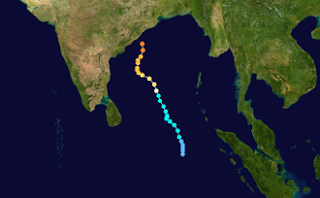100 Million people’s life will be affected due to India’s
worst cyclone Fani. Extremely Severe Cyclonic Storm Fani is currently a
powerful tropical cyclone that is about to make landfall in East India and is
threatening Bangladesh as an extremely severe cyclonic storm.
 |
Satellite-Image-of-Cyclone-Fani
Image Credit- National Oceanic and Atmospheric Administration
|
What is
Cyclone Fani?
Cyclone Fani is a tropical cyclone which started from Eastern
India, and will threated to Bangladesh as well. This is the first severe cyclonic
storm of the 2019 .
How did
the cyclone Fani Originate?
Fani originated from a tropical depression near west of
Sumatra in Indian Ocean on 26th April.
 |
The-track-of-cyclone-Fani
|
Who
watches over tropical disturbance in India?
The Joint Typhoon
Warning Center (JTWC) monitored a tropical disturbance that formed in the
North Indian Ocean, and designated it with the identifier 01B.
Fani slowly drifted westward, finding itself in an area
conductive for strengthening. The system intensified and two days after being
named, it became Cyclone Fani, the second named storm of the season.
Fani moved northward, struggling to intensify as moderate
vertical wind shear hampered its progress. After moving away from the wind
shear, Fani began to rapidly intensify, and
became an extremely severe
cyclonic storm on 30 April 2019, the first severe cyclonic storm of the
season.
However, this is evident that 2019 will bring more disasters
due to rising heat of the earth.
The government’s agencies and various scientific agencies have
warned about more cyclones. Some of the warning of reports are given below.
 |
| A picture that shows the rise in Sea Level due to climate change |
According
to the U.S. Environmental Protection Agency (EPA), barring fire, floods are the
most common natural disaster affecting Americans. Floods are a factor in 90
percent of natural disasters.
Weather is experienced for short period of time for an hour or a day while climate is the average weather and its variability over a long period of time.
Why do Natural Calamities happen?
Floods can occur due to both natural
and man-made reasons. Storm events can create flood waters that exceed the
capacity of the environment or man-made structures.
Levees and dams provide a false sense
of security as became evident during the Great Flood of 1993 in the Upper
Mississippi River valley and even in India the constant flood occurs.
A painful lesson was learned.
Wetlands destruction removed a natural means to absorb floodwaters.
Difference between weather and Climate Change
Weather is experienced for short period of time for an hour or a day while climate is the average weather and its variability over a long period of time.
Why do Natural Calamities happen?
Due to change in the climate
frequency of catastrophic events like- Cyclone, floods, thunder storm will be
on rise. The reasons vary for every event, but the most dangerous reason is the warming of the earth. Rise in temperature melts glacier and wind turns into storms due to low pressure area created by warm air.
This balancing act of the nature often
creates storms and heavy rains. It is observed from the recent
devastations post flood that economic cost is also huge.
Can natural disaster be prevented?
Not all-natural disasters can be
prevented. Each natural disaster has its own factors and complications.
Understanding the basic principles of ecology can provide keys to lessening
their effects. Nature evolved with natural disasters and disturbance. The best
prevention is looking at the strategies found in nature.
The prevention is better than cure
The technological advancement
is at peak, and due to scientific discovery there are models and steps to build
a climate resilient infrastructure.
The economy must be sustainable
and adaptable to the challenges. The Infrastructure that allows economy to grow
and sustain is the need of the hour. Infrastructure consists of high value
assets for long terms like bridges, rocks and power stations etc.
What is climate resilient Infrastructure?
 |
| Click Here! |
What is climate resilient Infrastructure?
Climate Resilient
Infrastructure is designed to mitigate the vulnerable impacts of the climate
change. It can safeguard and strengthen developing countries’ economic growth.
Role of the
government
The government has its role to
play and adapt important elements for national policies. It will help setting
up standards and a well prepared National Infrastructure Plan. The government
can push experts of various fields and bring different people like owners,
investors, professions together. The government can help in maximizing the
opportunities to grow greener, more modern and sustainable world.
The possible measures can be-
1. Ensuring
Infrastructure is resilient to potential increase in extreme weather events
such as storms, floods, and heat waves as well as extreme cold weather.
2. Ensuring
investment is made
3. Building
the flexibility so that according to the demand infrastructure can be modified.
4. Ensuring
that infrastructure organizations and professionals have the right skills and
capacity to implement adaptation measures.
For the purpose the government
has to identify core sectors first like – communication, health, emergency
services, energy, water, food, and transport etc. The infrastructure and
adaptation projects can be first focused on these sectors.
What is the world
doing about it?
There are countries who are
working efficiently like Australia identified adaptable and secure water
supplies to cope with climate change as one of its seven key objectives. The
country has also established a climate change adaptation project which included
developing a standard climate change adaptation system for organizations.
 |
| Read About It! |
Denmark is working on road
regulations and railway standard. These are being revised with consideration of
expected climate change. The Danish Environmental Protection Agency published
guidelines in 2007 in order for Municipalities to take climate change into
account.
Japan issued a series of
practical guidance on strategic climate change adaptation planning.
New Zealand Infrastructure Plan
identified in 2010 the impacts of Climate change as one of the long
term key trends to be addressed.
USA, also established
infrastructure working group to analyses the impact from climate change on its
infrastructure and strategies to adapt it.
What are challenges
and Barriers?
The path of building a climate
resilient infrastructure is not easy, there are certain challenges identified
by various agencies. For example-
1. Information
Gaps: Information must be provided as a public good to help public and private
sector organizations to understand that what climate change could mean.
2. Managing
Uncertainties: There are evidences available but time, nature and scale can not
be predicted related to climate change.
3. Balancing
Priorities: Climate resilience should be balanced against the priorities. The
area has been identified, and according to the risk the priorities should be
decided.
4. Shorter
term Regulator Focus: The strong emphasize remains on short term value, which
can be adding to the climate unpredictability.
 |
Donate us - via PAYTM
via PAYPAL
|













